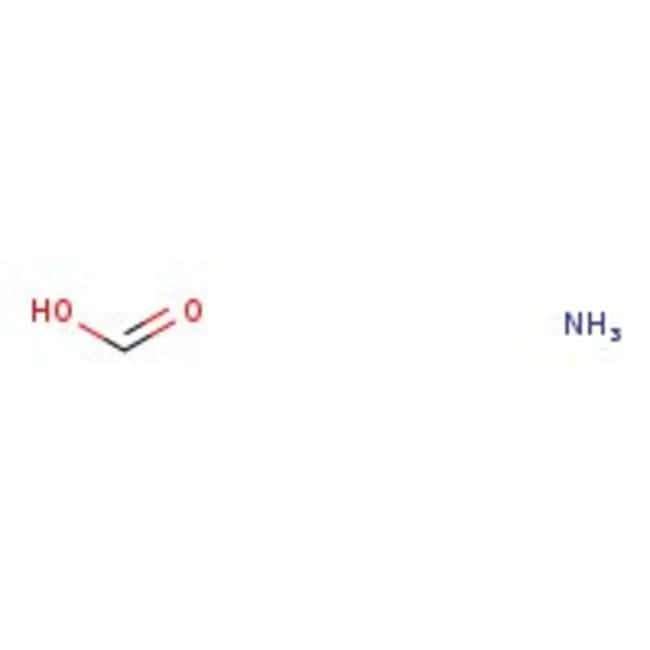Search Thermo Fisher Scientific
Thermo Scientific Chemicals
Ammonium formate, 97%, Thermo Scientific Chemicals
Catalog number A10699.30
also known as A10699-30
Price (USD)/ Each
33.65
Online exclusive
37.30 Save 3.65 (10%)
-
Quantity:
250 g
Price (USD)/ Each
33.65
Online exclusive
37.30 Save 3.65 (10%)
Ammonium formate, 97%, Thermo Scientific Chemicals
Catalog numberA10699.30
Price (USD)/ Each
33.65
Online exclusive
37.30 Save 3.65 (10%)
-
Chemical Identifiers
CAS540-69-2
IUPAC Nameformic acid amine
Molecular FormulaCH5NO2
InChI KeyVZTDIZULWFCMLS-UHFFFAOYSA-N
SMILESN.OC=O
View more
Specifications Specification Sheet
Specification Sheet
CommentMaterial sourced in UK and US
Identification (FTIR)Conforms (UK-sourced material)
FormCrystals or powder or crystalline powder
Appearance (Color)White
Assay (Non-aqueous acid-base Titration)≥96.0 to ≤104.0% (UK-sourced material)
View more
Ammonium formate is widely used in various organic reactions like Leuckart reaction which involves the reductive amination of aldehydes and ketones. It serves as a buffer in high performance liquid chromatography (HPLC) and liquid chromatography-mass spectrometry (LC/MS). It finds application in palladium on carbon (Pd/C) reduction of functional groups. For example, reduction of alkenes to alkanes and formaldehyde to methanol. It is also used to prepare formic acid insitu as well as used to store formic acid by making it as an ammonium salt.
This Thermo Scientific Chemicals brand product was originally part of the Alfa Aesar product portfolio. Some documentation and label information may refer to the legacy brand. The original Alfa Aesar product / item code or SKU reference has not changed as a part of the brand transition to Thermo Scientific Chemicals.
Applications
Ammonium formate is widely used in various organic reactions like Leuckart reaction which involves the reductive amination of aldehydes and ketones. It serves as a buffer in high performance liquid chromatography (HPLC) and liquid chromatography-mass spectrometry (LC/MS). It finds application in palladium on carbon (Pd/C) reduction of functional groups. For example, reduction of alkenes to alkanes and formaldehyde to methanol. It is also used to prepare formic acid insitu as well as used to store formic acid by making it as an ammonium salt.
Solubility
Soluble in water, liquid ammonia and alcohol.
Notes
Hygroscopic. Incompatible with strong acids and strong oxidizing agents.
Ammonium formate is widely used in various organic reactions like Leuckart reaction which involves the reductive amination of aldehydes and ketones. It serves as a buffer in high performance liquid chromatography (HPLC) and liquid chromatography-mass spectrometry (LC/MS). It finds application in palladium on carbon (Pd/C) reduction of functional groups. For example, reduction of alkenes to alkanes and formaldehyde to methanol. It is also used to prepare formic acid insitu as well as used to store formic acid by making it as an ammonium salt.
Solubility
Soluble in water, liquid ammonia and alcohol.
Notes
Hygroscopic. Incompatible with strong acids and strong oxidizing agents.
RUO – Research Use Only
General References:
- Reagent for N-formylation of secondary amines and anilines: Tetrahedron Lett., 41, 9149 (2000).
- Widely used as a hydrogen donor in catalytic hydrogen transfer reductions. Review: Synthesis, 91 (1988). See also Palladium, A12012, Cyclohexene, A11359, Hydrazine monohydrate, A14005, Formic acid, A13285 and Sodium hypophosphite monohydrate, A13385.
- Examples include:
- Reduction of aryl nitro groups to amines: Tetrahedron Lett., 25, 3415 (1984). For reductive cyclization of an o-nitrobenzyl ketone to an indole, see: Org. Synth. Coll., 9, 601 (1998). Hydrogenolysis of N-benzyl groups: Synthesis, 53 (1987); Tetrahedron Lett., 28, 515 (1987). Reduction of aldehydes and ketones to methyl and methylene groups: Tetrahedron Lett., 29, 3741 (1988). The temperature- and solvent-dependencies of this type of reaction have been studied: Synth. Commun., 22, 2673, 2683 (1992). Selective reduction of the heterocyclic ring of quinolines and isoquinolines: Synth. Commun., 20, 2815 (1990). Reduction of pyridine N-oxides to piperidines: J. Org. Chem., 66, 5264 (2001). Regioselective reduction of epoxides: J. Org. Chem., 60, 4922 (1995). Ammonium formate was found to be a more active H donor than either sodium formate or formic acid in the catalytic hydrogenolysis of aryl chlorides. For a comparative mechanistic study of this reaction, see: J. Org. Chem., 60, 1347 (1995).
- A simple microwave-assisted method for catalytic transfer hydrogenation in ethylene glycol or 1,3-propanediol has been reported: J. Org. Chem., 64, 5746 (1999).
- Sridhar, M.; Ferri, D.; Elsener, M.; Bokhoven, J. A. V.; Krocher, O. Promotion of Ammonium Formate and Formic Acid Decomposition over Au/TiO2by Support Basicity under SCR-Relevant Conditions ACS. Catal 2015, 5 (8), 4772-4782.
- Su, J.; Lu, M.; Lin, H.. High yield production of formate by hydrogenating CO2 derived ammonium carbamate/carbonate at room temperature. Green Chem. 2015, 17 (5), 2769-2773.

